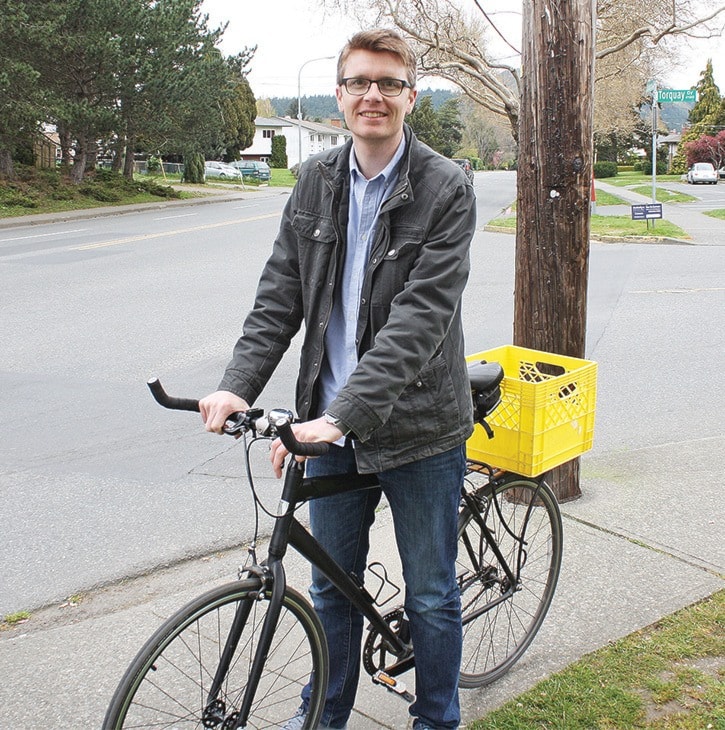During their morning break, a group of Lambrick Park secondary students make a ritual pilgrimage to the Starbucks and 7-11 in Feltham Village.
As they saunter through the strip mall parking lot, it gives neighbourhood resident Matt Boyd, a planning professional, the opportunity to explain the definition of desire lines.
“Watch these 20 or so students cutting through this parking lot to save time rather than use the Shelbourne Street sidewalk. It’s going to be like that all day,” Boyd says. “If the parking lot pavement was grass, you’d see a trail or desire line worn in by regular foot traffic, the same way you see trails worn into grass paths cutting across school fields and parks. (Strip mall) parking lot is designed with cars as a priority but the reality is there’s hundreds of pedestrians coming through here each day, way more than the number of cars.”
Few see Feltham the way Boyd does. He grew up in the neighbourhood and graduated from Lambrick secondary. After time away, he’s since returned with his wife and kids, aged one and five. A dedicated cycling commuter and proud pedestrian, Boyd watches similar situations unfold in Feltham Village every day. As a personal project, he’s accumulating a list of improvements to make Feltham a more engaging place to be and support the growing trend of placemaking.
“Placemaking is as much a way of thinking as it is a physical outcome, creating places that are loved by people,” says former City of Vancouver planner Brent Toderian, who now consults with municipalities across Canada and has a personal interest in what makes placemaking happen. “Walkability and placemaking overlap, and it’s important to remember to be a great place it has to be a sticky place that makes you stop and linger,” he says.
The challenges with Feltham, just like the rest of Gordon Head, are that the area is car-oriented.
“Feltham is designated by Saanich as a town centre,” says Boyd, whose ideas are all designed around removing the stresses that occur when auto traffic mixes with pedestrians and cyclists. He posts them at his blog – trainboat.com.
“(This area) has a lot of great things going for it and I’d like people to think of it as a place rather than an after thought,” Boyd adds. “It has bus routes, access to the Lochside Trail and the Gordon Head Local Connector cycling route to the university. It has facilities, shops, restaurants, businesses, Gordon Head Recreation Centre and the surrounding sports complex, plus the Mount Doug Market grocery store. … I’d like to see it move towards active transportation, walking and cycling.”
Placemaking, in general, is not anti-car, Toderian says, but if the design of an area prioritizes cars, then it’s you’re not a place for people.
The daily migration of store-seeking Lambrick students should have gone around the parking lot and used the sidewalk on Shelbourne, but that’s just not how people work, Boyd says.
Victoria’s Fernwood and Quadra Village are two good examples of placemaking where barriers re-route vehicle traffic and support safer a infrastructure for biking and walking.
With Lambrick Park secondary, Gordon Head rec and lawn bowling, the skate park and the baseball diamonds all within two minutes of the Feltham intersection, the area could be a lot stickier.
“Feltham is aging, it needs upgrades,” Boyd says. “We have an aging demographic in this area with increasing density and demands. There are new developments on Shelbourne only 100 meters south of Feltham and the number of university students has increased as the University of Victoria has grown.”
Boyd credits the improvements laid out in the municipality’s longterm Shelbourne Valley Action Plan, though there are some smaller, immediate changes that could yield big returns, he says.
“There are lots of bikes parked out front of the rec centre, but more would show up if there was improved bike lanes and better access.” Boyd says. “It’s a hidden demand.”
There are bike lanes coming to Shelbourne Street (by Saanich’s own admission, they could take up to 30 years) but there are no cycling lanes on either side of Feltham. Worse is the one-kilometre “highway” from Feltham north to Arbordale Avenue,” Boyd says.
“It’s unintentional, but drivers can see far down the road and without and crosswalks and lights, it gives drivers the illusion of a highway,” he says.
Residents also tend to be unwilling to go as much as 600 metres out of their way to cross from the west side of Shelbourne to the east, whether it’s to get to Lambrick Park secondary, Mount Doug Market or Gordon Head rec centre. The current draft of the 30-year Shelbourne Valley Action Plan introduces more crosswalks for the area, but doesn’t commit to any as of yet. (The draft report is undergoing changes and will return to council later this spring.)
Until more improvements are made, Feltham will need to rely on “smart pedestrians,” Boyd says.
“There are blind spots created by the power poles which protrude into the Feltham/Shelbourne intersection, so people who walk here have learned the danger spots. But there are days I’ve held my breath when a senior resident of the Berwick House (on the southwest corner) attempts to cross the street and is clearly unaware of the dangers.”
reporter@saanichnews.com
